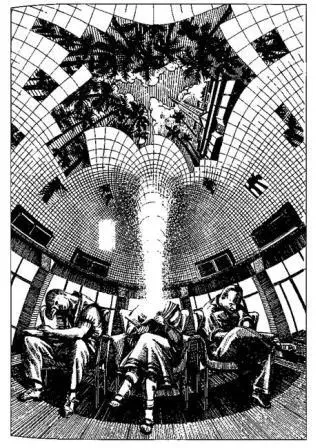Ursula K. Le Guin
CHANGING PLANES
Stories
THIS BOOK WAS WRITTEN when the miseries of air travel seemed to be entirely the doing of the corporations that ran the airports and the airlines, without any help from bigots with beards in caves. Spoofing the whole thing was easy. They were mere discomforts, after all. Things have changed, but the principle on which Sita Dulip’s Method is founded remains valid. Error, fear, and suffering are the mothers of invention. The constrained body knows and values the freedom of the mind.

THE RANGE OF THE AIRPLANE—a few thousand miles, the other side of the world, coconut palms, glaciers, the poles, the Poles, a lama, a llama, etc.—is pitifully limited compared to the vast extent and variety of experience provided, to those who know how to use it, by the airport.
Airplanes are cramped, jammed, hectic, noisy, germy, alarming, and boring, and they serve unusually nasty food at utterly unreasonable intervals. Airports, though larger, share the crowding, vile air, noise, and relentless tension, while their food is often even nastier, consisting entirely of fried lumps of something; and the places one has to eat it in are suicidally depressing. On the airplane, everyone is locked into a seat with a belt and can move only during very short periods when they are allowed to stand in line waiting to empty their bladders until, just before they reach the toilet cubicle, a nagging loudspeaker harries them back to belted immobility. In the airport, luggage-laden people rush hither and yon through endless corridors, like souls to each of whom the devil has furnished a different, inaccurate map of the escape route from hell. These rushing people are watched by people who sit in plastic seats bolted to the floor and who might just as well be bolted to the seats. So far, then, the airport and the airplane are equal, in the way that the bottom of one septic tank is equal, all in all, to the bottom of the next septic tank.
If both you and your plane are on time, the airport is merely a diffuse, short, miserable prelude to the intense, long, miserable plane trip. But what if there’s five hours between your arrival and your connecting flight, or your plane is late arriving and you’ve missed your connection, or the connecting flight is late, or the staff of another airline are striking for a wage-benefit package and the government has not yet ordered out the National Guard to control this threat to international capitalism so your airline staff is trying to handle twice as many people as usual, or there are tornadoes or thunderstorms or blizzards or little important bits of the plane missing or any of the thousand other reasons (never under any circumstances the fault of the airlines, and rarely explained at the time) why those who go places on airplanes sit and sit and sit and sit in airports, not going anywhere?
In this, probably its true aspect, the airport is not a prelude to travel, not a place of transition: it is a stop. A blockage. A constipation. The airport is where you can’t go anywhere else. A nonplace in which time does not pass and there is no hope of any meaningful existence. A terminus: the end. The airport offers nothing to any human being except access to the interval between planes.

It was Sita Dulip of Cincinnati who first realised this, and so discovered the interplanar technique most of us now use.
Her connecting flight from Chicago to Denver had been delayed by some unspeakable, or at any rate untold, malfunction of the airplane. It was listed as departing at 1:10, two hours late. At 1:55, it was listed as departing at 3:00. It was then taken off the departures list. There was no one at the gate to answer questions. The lines at the desks were eight miles long, only slightly shorter than the lines at the toilets. Sita Dulip had eaten a nasty lunch standing up at a dirty plastic counter, since the few tables were all occupied by wretched, whimpering children with savagely punitive parents, or by huge, hairy youths wearing shorts, tank tops, and rubber thongs. She had long ago read the editorials in the local newspaper, which advocated using the education budget to build more prisons and applauded the recent tax break for citizens whose income surpassed that of Rumania. The airport bookstores did not sell books, only bestsellers, which Sita Dulip cannot read without risking a severe systemic reaction. She had been sitting for over an hour on a blue plastic chair with metal tubes for legs bolted to the floor in a row of people sitting in blue plastic chairs with metal tubes for legs bolted to the floor facing a row of people sitting in blue plastic chairs with metal tubes for legs bolted to the floor, when (as she later said), “It came to me.”
She had discovered that, by a mere kind of twist and a slipping bend, easier to do than to describe, she could go anywhere—be anywhere—because she was already between planes.
She found herself in Strupsirts, that easily accessible and picturesque though somewhat three-dimensional region of waterspouts and volcanoes, still a favorite with beginning inter-planary travelers. In her inexperience she was nervous about missing her flight and stayed only an hour or two before returning to the airport. She saw at once that, on this plane, her absence had taken practically no time at all.
Delighted, she slipped off again and found herself in Djeyo. She spent two nights at a small hotel run by the Inter-planary Agency, with a balcony overlooking the amber Sea of Somue. She went for long walks on the beach, swam in the chill, buoyant, golden water—“like swimming in brandy and soda,” she said—and got acquainted with some pleasant visitors from other planes. The small and inoffensive natives of Djeyo, who take no interest in anyone else and never come down to the ground, squatted high in the crowns of the aim-palms, bargaining, gossiping, and singing soft, quick love songs to one another. When she reluctantly returned to the airport to check up, nine or ten minutes had passed. Her flight was soon called.
She flew to Denver to her younger sister’s wedding. On the flight home she missed her connection at Chicago and spent a week on Choom, where she has often returned since. Her job with an advertising agency involves a good deal of air travel, and by now she speaks Choomwot like a native.
Sita taught several friends, of whom I am happy to be one, how to change planes. And so the technique, the method, has gradually spread out from Cincinnati. Others on our plane may well have discovered it for themselves, since it appears that a good many people now practice it, not always intentionally. One meets them here and there.
While staying with the Asonu I met a man from the Can-densian plane, which is very much like ours, only more of it consists of Toronto. He told me that in order to change planes all a Candensian has to do is eat two dill pickles, tighten his belt, sit upright in a hard chair with his back not touching the back, and breathe ten times a minute for about ten minutes. This is enviably easy, compared to our technique. We (I mean people from the plane I occupy when not traveling) seem unable to change planes except at airports.
The Interplanary Agency long ago established that a specific combination of tense misery, indigestion, and boredom is the essential facilitator of interplanary travel; but most people, from most planes, don’t have to suffer the way we do.
Читать дальше











